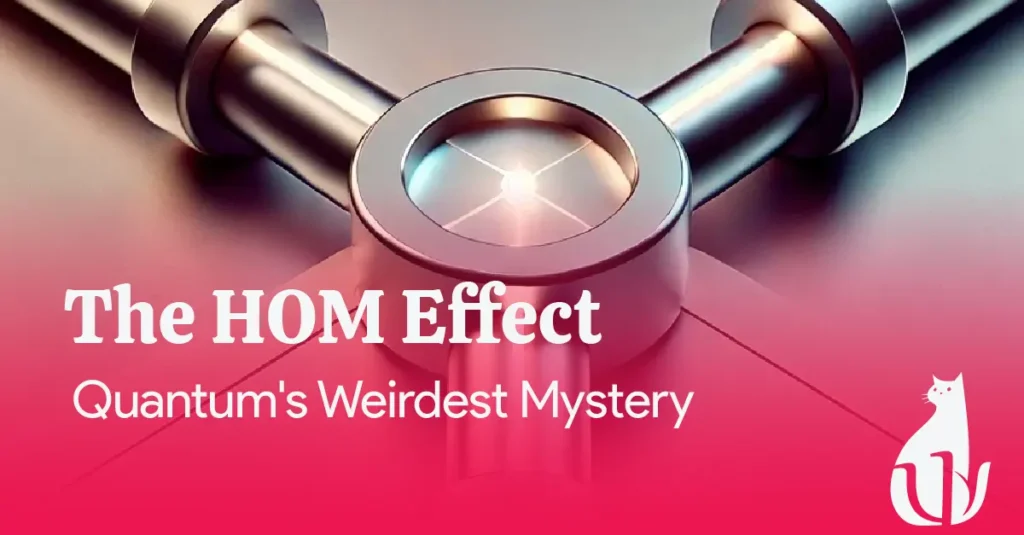PsiRealm
Quantonix Research • January 2024

The quantum world is full of microscopic mysteries we still don't understand. One of these, called by some as the most "quantum" effect on Earth, laid the foundation for some of the most critical advancements in optical-based quantum computing, imaging, and sensing to date.
Back in 1987, various papers detailed the working of a Beam Splitter, a foundational instrument in linear optics based on the laws of Quantum Mechanics.
Sometime later, Hong, Ou, and Mandel come across a shocking discovery. They experimented with what happens when two horizontally and one vertically polarized photons collide from different input ports.
If the Beam Splitter is "balanced" (we will define this later), the two output ports behave like a Bell State Measurement, aka Entanglement!
This phenomenon, named the HOM (Hong-Ou-Mandel) Effect, also known as the Two-Photon Interference Effect, is often referred to as the "heart of quantum mechanics" with no analog in classical physics.
But to understand why this phenomenon is so fundamental to quantum, we must first take a look at the humble Beam Splitter.
In essence, a Beam Splitter mixes two optical inputs (often called modes). It is the building block of any linear optical quantum information processing system.
It has two input ports (as you might guess), labeled a and b, as well as two output ports labeled c and d. The inputs are split between the two output ports depending on two complex parameters called r and t, reflectance and transmittance respectively.
If both parameters are equal to 1/sqrt(2), it creates a 50/50 Beam Splitter, also known as a "balanced" Beam Splitter. While this number is ideal since we are assuming the Beam Splitter does not absorb any of the photons, this is the setup we will use to describe what The HOM Effect is.
Let's take a 50/50 Beam Splitter, and assume the same setup as before. You can expect 4 possible outcomes:
Since the two inputs have opposite polarizations, with no surprises, we obtain all the classically expected outcomes.
However, let us now consider what happens when both photons are indistinguishable. Since they now have the same polarization state, what will happen?
Well as it turns out, we find a completely NEW type of interference effect that is very different from the interference of a single photon with itself.
What we observe is destructive interference of the two-photon states corresponding to photons exiting opposite output ports, and constructive interference to photons exiting through the same output ports!
In addition to being a weird and wonderful quantum optics phenomenon, it has its use cases in quantum information processing. It is one of the primary tools for creating and analyzing Entangled States!
What's interesting is that for the |Ψ+⟩ and |Φ±⟩ states, the output photons may exit the Beam Splitter together through the same output ports (with some assumptions). This behavior is called "bunching".
However, in the case of |Ψ−⟩, the output photons may exit the Beam Splitter in opposite output ports (also with some assumptions) — this behavior is called "anti-bunching".
Since The HOM Effect is so foundational to Quantum Optics, you can imagine the wide variety of applications it appeals to.
One application I want to mention is Quantum Microscopy. You can use The HOM Effect to achieve unprecedented depth resolution in microscopy.
The method uses the quantum interference of indistinguishable photon pairs to reconstruct surface profiles of transparent samples with micrometer precision, even in extremely low-light conditions.
The result? Nanometer-scale depth sensitivity, high-resolution images with as few as 7 photon pairs per frame. The device is robust against noise from environmental disturbances, making it significantly more reliable.
When these qudits are sent into the beam splitter, the way they interact depends on how similar or different they are. If the two qudits are the same, they will bunch together. This is a direct result of their perfect similarity.
However, if the qudits are different, even slightly, then there's a chance they won't bunch together. The less similar they are, the more likely they are to go in different directions ("anti-bunching").
And so with these properties in mind, we can extend The HOM Effect to higher dimensions to measure the similarity between two quantum states — If there's no bunching, it means the states are completely different. And if there's perfect bunching, it means the states are identical.
I think you will agree that The HOM Effect has proven itself to be much more than a curious anomaly.
Since its discovery, it has become a cornerstone in the development of quantum technologies, particularly in the realms of quantum computing, imaging, and sensing.
Whether it's creating entangled states for quantum communication, achieving nanometer-scale precision in quantum microscopy, or extending to higher-dimensional qudits, the HOM Effect continues to push the boundaries of what is possible in the quantum world.
ready to
Collaborate?
START HERE